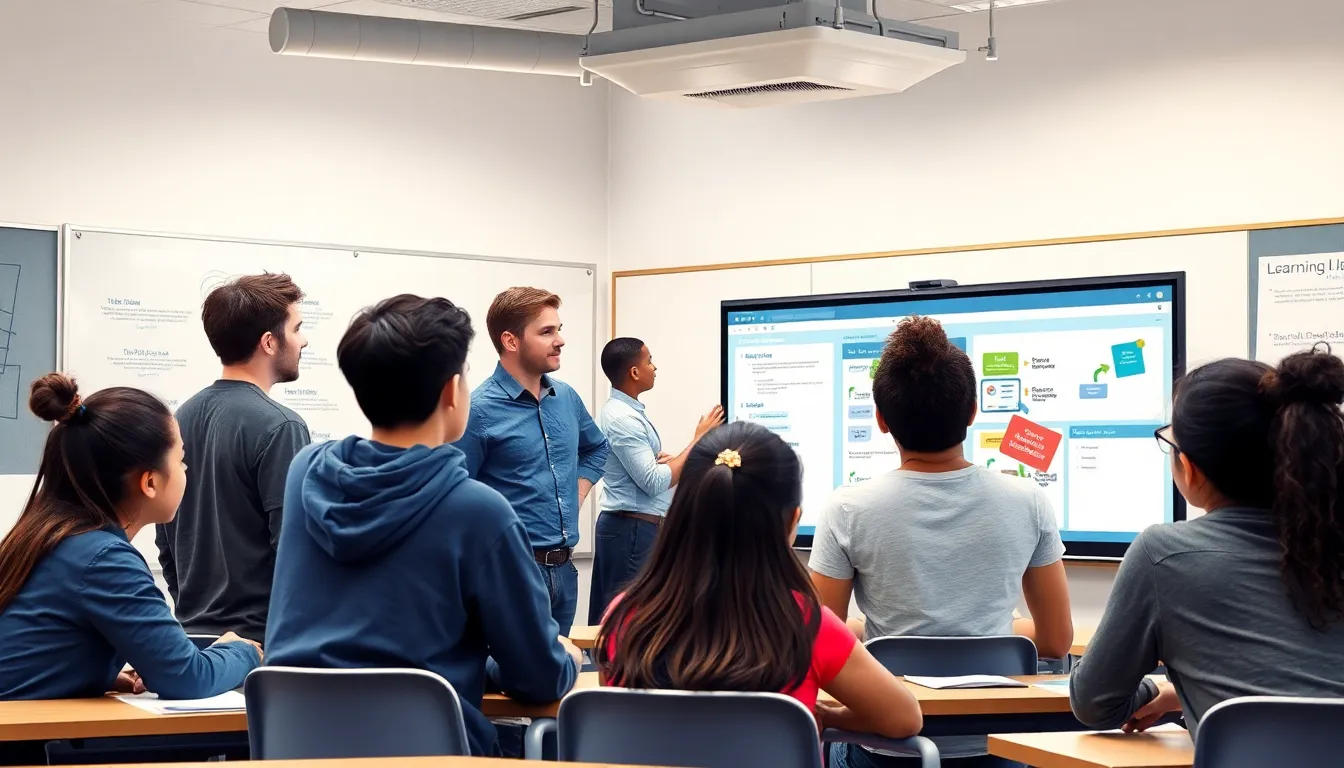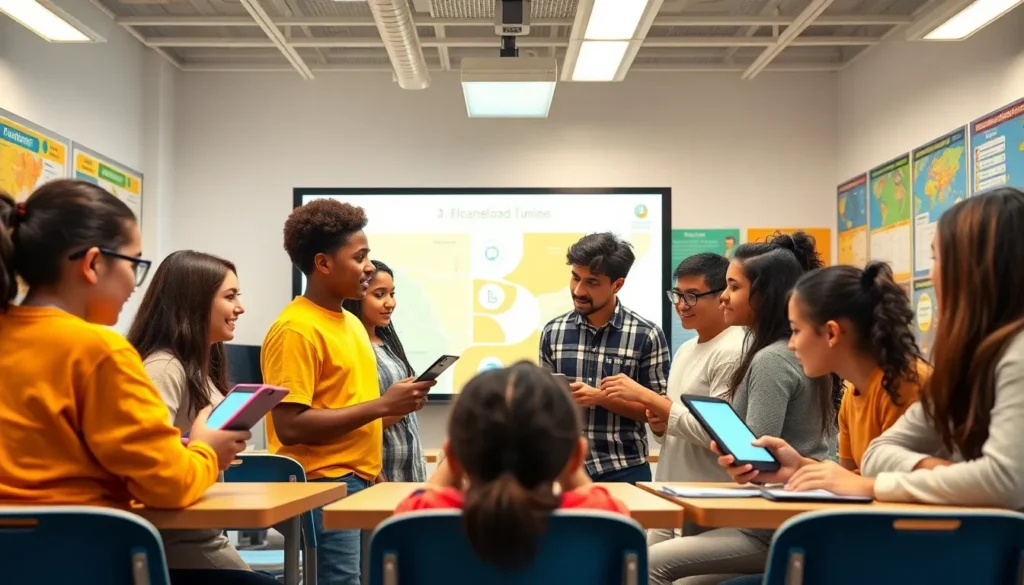Table of Contents
ToggleImagine walking into a classroom where the chalkboard’s replaced by interactive screens and textbooks are just a swipe away. Welcome to the smart classroom—a place where learning meets technology in the most exciting way possible. Gone are the days of boring lectures and endless note-taking. Instead, students engage with dynamic content that makes education feel like an adventure.
Overview Of Smart Classrooms
Smart classrooms integrate advanced technology to enhance education quality. These environments utilize interactive displays, tablets, and digital boards, replacing conventional teaching methods. Learners engage more actively as teachers employ multimedia presentations and virtual simulations.
Flexibility characterizes smart classrooms, allowing teachers to customize lessons for diverse learning styles. Up-to-date software ensures that materials remain relevant, providing students with immediate access to current information. Wireless connectivity supports extensive internet resources, expanding learning opportunities beyond traditional textbooks.
Interactive learning experiences foster collaboration among students. Group projects commonly occur using online platforms that enable real-time feedback and teamwork. Assessment techniques adapt as teachers track student progress through data analytics, tailoring instruction effectively.
Moreover, smart classrooms promote inclusivity with assistive technologies for students with varying needs. Those tools support diverse learners, enhancing participation and comprehension. Additionally, automatic attendance systems and performance tracking streamline administrative tasks for educators.
Research indicates that smart classroom environments improve student engagement and retention rates. A study by the Education Technology Industry Network reported a 20% increase in student performance through technology integration. These results illustrate the substantial impact of interactive and adaptive learning environments.
Professional development for educators remains crucial as technology evolves. Continuous training ensures that teachers maximize smart classroom potential. With ongoing support, educators become adept at leveraging technology to foster a conducive learning atmosphere.
Overall, smart classrooms represent a paradigm shift in education. They embrace innovation while prioritizing student needs, adapting to the demands of a digital age. By fostering an engaging, collaborative atmosphere, these classrooms redefine the educational experience.
Features Of Smart Classrooms

Smart classrooms incorporate various technological elements that enhance the learning experience. These features encourage collaboration, interaction, and better access to resources.
Interactive Whiteboards
Interactive whiteboards serve as a central tool in smart classrooms. These devices allow teachers to present lessons dynamically, integrating videos, images, and live links. Students engage with materials directly on the board, fostering participation. Feedback becomes immediate as teachers assess responses in real-time. Spontaneous discussions arise, enriching the learning atmosphere. Additionally, these whiteboards contribute to a visually stimulating environment, catering to diverse learning styles.
Learning Management Systems
Learning management systems streamline course organization and content delivery. Teachers upload assignments, resources, and assessments, making them accessible anytime. Students track their progress and deadlines through dashboards, enhancing accountability. Communication features enable direct interaction between students and educators. Data analytics from these platforms provide valuable insights into performance trends. Frequent updates ensure content remains relevant, keeping pace with emerging educational needs. Ultimately, these systems promote a structured learning experience tailored to individual student goals.
Benefits Of Smart Classrooms
Smart classrooms offer numerous advantages that transform the educational landscape. They encourage active participation and provide tailored experiences for students.
Enhanced Student Engagement
Active learning emerges through the use of innovative technologies. Interactive displays capture students’ attention, fostering curiosity and involvement. Group activities and multimedia presentations promote collaboration among peers. Immediate feedback from digital tools keeps students motivated and invested. Customized learning experiences cater to unique preferences, making education feel more accessible and enjoyable. As a result, classrooms become vibrant environments where students thrive.
Improved Learning Outcomes
Evidence suggests that smart classrooms significantly boost academic performance. A 20% increase in student achievement correlates with the integration of technology. Data analytics help teachers monitor progress, enabling timely interventions. Interactive lessons allow for hands-on experiences that reinforce understanding. Students develop critical thinking and problem-solving skills through simulated scenarios. Enhanced access to resources ensures they can explore topics beyond the curriculum, deepening knowledge and comprehension. Therefore, these classrooms play a crucial role in cultivating successful learners.
Challenges Of Implementing Smart Classrooms
Implementing smart classrooms comes with several challenges that schools must navigate effectively.
Technological Barriers
Tech infrastructure plays a critical role in the success of smart classrooms. Limited internet connectivity often hinders access to online resources and software. Equipment quality can vary, leading to inconsistencies in classroom experiences. Outdated hardware may not support the latest educational tools, affecting the overall learning environment. Schools sometimes encounter budget constraints, which can limit the acquisition of essential devices like tablets or interactive displays. These barriers can impede the seamless integration of technology into teaching practices.
Teacher Training
Effective teacher training is essential for maximizing smart classroom potential. Many educators lack adequate familiarity with new technologies, which can create frustration and reduce effectiveness. Continuous training programs help staff become proficient in using digital tools. Workshops that focus on strategy and application ensure educators feel confident and prepared. Moreover, flexible professional development opportunities can cater to different skill levels among teachers. Prioritizing ongoing training helps cultivate a technologically adept workforce committed to enhancing student learning experiences.
Future Trends In Smart Classrooms
Enhanced technology will continue to shape smart classrooms, moving beyond traditional methods. Artificial intelligence tools can provide personalized learning experiences tailored to individual needs. Data-driven insights will enable educators to make informed decisions, optimizing lesson plans for diverse student populations.
Augmented reality applications may allow students to engage with content in immersive ways. These platforms can facilitate exploration beyond textbooks, providing experiential learning opportunities that enhance understanding. Mobile learning will likely gain traction, enabling students to access resources anytime and anywhere.
Collaboration tools will evolve, fostering communication among students and teachers more effectively. Online discussion boards and project management applications will support teamwork and peer-to-peer learning. Gamification elements will likely become more prevalent, making learning interactive and enjoyable.
Virtual classrooms could expand learning opportunities, allowing students to join from different locations. This flexibility may promote inclusivity, accommodating different learning styles and preferences. Mastery-based learning models may emerge, enabling students to progress at their own pace and emphasizing understanding over rote memorization.
Instructors will increasingly focus on integrating socio-emotional learning resources, promoting holistic development. Skills such as resilience, teamwork, and problem-solving will gain importance in curricula. Regular feedback mechanisms will likely become standard, guiding students with timely insights into their performance.
Emerging technologies will require ongoing professional development for educators, ensuring they remain adept with tools and techniques. Schools may prioritize partnerships with tech companies to access cutting-edge advancements. Educational institutions will likely embrace sustainability, implementing eco-friendly technologies that align with global initiatives.
Smart classrooms are revolutionizing the educational landscape by integrating advanced technology to enhance learning experiences. This innovative environment fosters engagement and collaboration among students while allowing for personalized instruction tailored to individual needs.
As technology continues to evolve, the potential for smart classrooms will only grow. Emerging tools like artificial intelligence and augmented reality promise to make learning even more interactive and immersive.
By prioritizing professional development for educators and embracing sustainable practices, schools can fully harness the benefits of smart classrooms. This transformation not only improves academic performance but also prepares students for a future where adaptability and critical thinking are essential.







